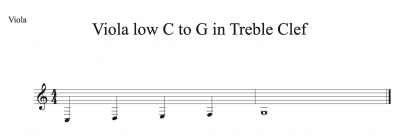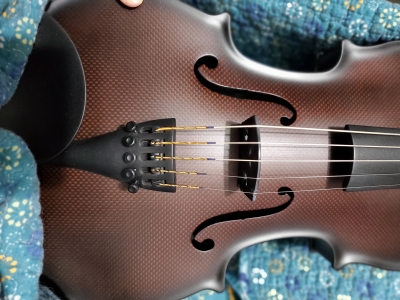Welcome to our forum. A Message To Our New and Prospective Members . Check out our Forum Rules. Lets keep this forum an enjoyable place to visit.
Currently working on errors from the latest (SimplePress) forum update. Many issues have been resoled and others are being worked on. Thank you for your patience.
 Topic RSS
Topic RSS



 (9 votes)
(9 votes) Member
 Offline
OfflineGreetings fellow Fiddlerman folks!
I have recently picked up a student model viola and have been alternating my playing between this viola and my violin. I am finding that doing this has been beneficial to me from an ear training and technique standpoint. I am surprised at the quality of this viola, which I bought for $40 on Marketplace. I experienced a similar effect when I play my guitars- if I alternate playing on my different instruments, I improve across the board on all of them. Can anyone help explain this phenomenon? Is it something similar to cross-training for physical sports activities?
Regulars







It is.
At conservatory level, many violin professors require all their students to learn the viola if they do not already play it. I think there are two benefits for violinists:
1) Getting used to a different finger spacing means being forced to listen for intonation rather than rely too much on muscle memory.
2) The viola is less forgiving with errors in coordination between the hands, because the strings don't respond as quickly to the bow. In addition, it needs more attention to tone quality in general. All this makes it extra important to pay attention to the bow hand.
Regulars
 Offline
Offline








JohnBAngel - Awesome to be Human, isn't it?
Our complex system of perception & how our brain manages to turn all that information into equally complex actions is something to cherish.
I'm no expert, but sounds like your ear training is paying off. All string instruments have similarities and you have been training yourself to find notes - this is reinforced. I look at the differences in the instruments as new (refreshing) brain games of "find the note/notes". By switching back and forth I think you sharpen your senses. Just keeps getting better... be aware of what you do & how.
If you look close I think you'll see similarities in cross-training for sports, too.
Good attitude!
Just make sure you protect your hearing.
I'm sorry if I sound condescending - I don't pretend to know your age.
I'm sure you'll hear from many of the great multi-instrument players here on the forum.
- Emily
Regulars
 Offline
Offline

@JohnBAngel and others. Are you playing a viola of a similar size to the violin (14” corpus) or a more substantial brethren?
It is almost too bad that the viola makes use of different scale notation. Always another thing to learn.
Success is the progressive realisation of a worthy ideal. —Earl Nightingale.
Member
 Offline
OfflineThanks for your thoughts Fiddlerman.
I get the added benefit of moving down into the alto clef, which should help me with my reading ability.
I am practicing the same tunes on both instruments, so I am getting the advantage of being able to play violin scales on the viola, albeit in different positions.
Then the benefits go back to taking these other positions on the viola and moving back into the violin ranges.
Can't begin to tell y'all how much I appreciate your expertise.
JohnBAngel
Regulars
 Offline
Offline





Yesterday was interesting.
A copy of Hindemith's Meditation for viola and piano arrived (a dollar+shipping!).
So I was playing, on the violin, the alto clef for the first time ever, sight-reading and simultaneously transposing up a fifth in order to play the same string number I'd be playing on a viola.
After about 15 minutes of that my brain felt like mashed potato, and I decided to "put it on the back burner" and maybe wait until I buy a viola! Or maybe that was just defeatist. Maybe I was just about to break through the wall!
Solutions:
I could keep at it.
I could find where I put my manuscript books and write it out, transposed, in the treble clef a line at a time.
For me the hardest thing about the alto clef is where those semitones are.
When you are used to the treble clef and that middle line is B and the next space above is a C. The way that semitone becomes a tone (C to D) is the hardest thing for me.
I wonder if I pretend it's the treble clef and transpose up an augmented fifth that will be the easiest solution! Nope, that won't work at all - some notes will need to be transposed up a 6th. (e.g. the D, looks like a treble C, but needs to go up to A)
Two-set have got it all wrong - violists are evil geniuses. This could be a conspiracy that makes the X-Files look like Sesame Street!

Andrew
Verified human - the ignominy!
Regulars
 Offline
Offline








Gordon Shumway - Wow!
You have a lot of intestinal fortitude to attempt all that in your head - bravo!
Just today mentioned in another thread that if I'd bought a viola instead of a 5-string violin I'd just play violin parts... but lower.
Most of the music I play isn't as complicated/long as what you play, so easy for me to play around in alternate Keys. I would definitely have to transpose a piece like Hindemith's to play it differently.
- Emily
New member
 Offline
OfflineRegulars
 Offline
Offline








Now that I'm waiting for my new Glasser 5-string Viola, I'm looking back on this thread - having played my 5-string Violin for a longer period.
- I can say I still read Alto Clef slower than Treble Clef.
- I still think of the 'C' string as Violin.
- I still appreciate that lower strings are beautiful, but take more work to get them to respond in the best way.
- and likewise, it's like completely switching gears to play the 'E' and 'A' strings delicately.
- Having now played in a couple different positions and tunings, I'm hopelessly addicted to the versatility of 5 strings.
- I still recommend a 5 string to all creative Violinists & Violists!
I'm really looking forward to exploring the differences between the Viola and Violin bodies and finger spacing, but believe I may be better prepared than most who jump from one instrument to the other.

...different models have different string spacing - there's a 5-string available for all sizes of hands/fingers to enjoy!
- Emily
Regulars
 Offline
Offline








Okay, it's been been 3 weeks since I got Edgar, my new 5-string VIOLA!
See ABitRusy's and my "Mini Party":
1.) The hardest thing for me to get used to is the greater distance between the strings. Let's face it, I'm much more used to fast string crossings than shifting. (lol)
🤔... looking on the brighter side, maybe it's good to have another excuse for me to work on shifting. 🙄
2.) Vibrato isn't any harder... just still hard. 🤭
3.) Distance between notes isn't as much of an issue as I originally anticipated - always searching for the best intonation, anyway. 😏
4.) Edgar definitely felt like a VIOLA for the 1st few days, then seemed a completely different instrument. 😳
It was a joke at first, but after 3 weeks of getting acquainted - I'm afraid I really do see Edgar as a 5-string FIDDLE, in a Viola Suit... with just a much deeper voice. 😲
...only did a short comparison video of 5-string VIOLIN vs. 5-string VIOLA for SharonC's Party, about a week ago:
All I can say is, I HIGHLY recommend you consider a 5-string VIOLA... or 5-string VIOLIN, from the FIDDLERSHOP - for YOUR first, or next FIDDLE!
- Emily
Regulars
 Offline
Offline





By 5-string viola, do you mean that its lowest string is F rather than C?
Incidentally, Pierre commented on the number of ledger lines if you use the treble clef, but something I hadn't realised until about a year ago was that flute music always uses ledger lines above the stave - never 8ve markings.
Andrew
Verified human - the ignominy!
Regulars
 Offline
Offline








@Gordon Shumway -
Both 5-string Violins & 5-string Violas come strung as C, G, D, A, E.
A lower, F4 string is available if you wish to remove the E string and move the C, G, D, A over. I've been considering this.
Glasser now makes a 6-string "Violin", strung F, C, G, D, A, E. Which I think technically makes it considered a small Viola de Gamba(?)
More than 5 strings used to seem a bit overwhelming to me, until I understood the relationship from one string to the next was the same, in ascending or descending order, no matter how many strings there are (unlike Ukulele).
I don't freak out seeing ledger lines. Piano music uses plenty of them above the Treble Clef and also below the Bass Clef.
It shouldn't be a big deal to write music for the 5-string Violin or 5-string Viola all in Treble Clef, but I can see where it will drive some people nuts by not including the Alto Clef.
Don't most Violists start by learning to play Violin and reading Treble Clef, anyway?
Regulars
 Offline
Offline





ELCBK said I understood the relationship from one string to the next was the same, in ascending or descending order, no matter how many strings there are (unlike Ukulele).
Yes, the intervals between strings is what affects our treatment of them.
On most bowed instruments it's always a perfect 5th (perfect 4th on bass)
But on guitar, lute, uke, it's 4th, 3rd, 4th - reentrancy is a red herring.
What's the D string on a guitar is tuned to C# on the lute (variants aside), but that just means the intervals are 4th, 4th, 3rd, 4th, 4th instead of 4th, 4th, 4th, 3rd, 4th.
Andrew
Verified human - the ignominy!
Regulars
 Offline
Offline








Regulars
 Offline
Offline





For me the arthritis is the main thing - violin is least painful, guitar is most painful!
Having said that, I assumed Keith Richards coped by means of drugs, but my arthritis seems to be stabilising...
I kind of wish I'd taken up popular guitar earlier, as it's not just about 6 strings - it's about using the bottom three (tuned in 4ths) for bass and the top three for melody/chordal accompaniment to the bass, so it's potentially an interesting instrument, but those days are gone.
Andrew
Verified human - the ignominy!
Regulars
 Offline
Offline






@elcbk said.." Both 5-string Violins & 5-string Violas come strung as C, G, D, A, E. "
Important fact i overlooked..ignored..when buying mine. Im sure you tried to suggest it but I went 4 string. Looking at that now and having the standard viola i can see the advantages of one strung like you said...coming from fiddle. I still probably wouldve went the route i did due to cost. But I agree, the 5 string viola wouldve been a really good fit with existing fiddle.
1 Guest(s)


 Log In
Log In Register
Register























